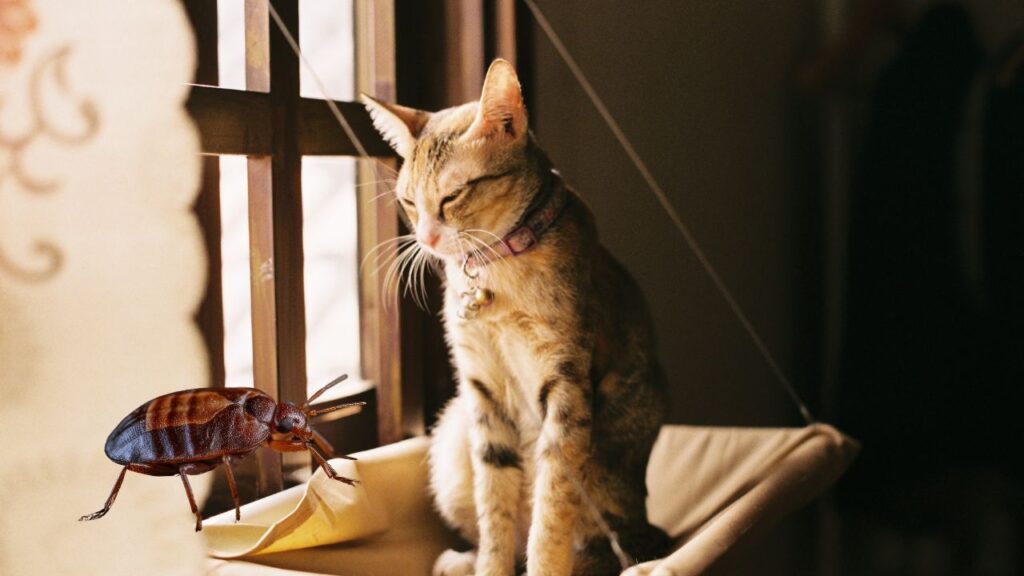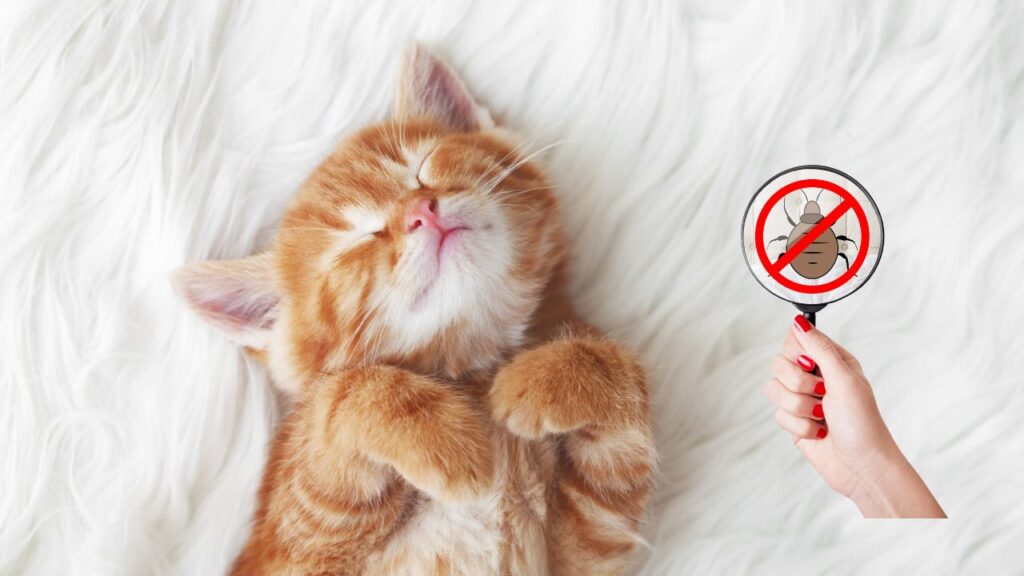When you think of bed bugs, your mind probably jumps to creepy crawlers hiding in your mattress or lurking in the corners of your bedroom. But do bed bugs travel on cats? This question might surprise many pet owners, leading to concerns about both their furry friends and their homes. Let’s delve into the fascinating relationship between bed bugs and cats, exploring how these pests operate and what you can do to protect your beloved pets and your living space.
Contents
- 1 Understanding Bed Bugs: The Basics
- 2 Do Bed Bugs Travel on Cats?
- 3 The Impact of Bed Bugs on Cats
- 4 What to Do If You Suspect Bed Bugs on Your Cat
- 5 Comparing Bed Bugs with Other Common Pests
- 6 Preventative Measures: Keeping Bed Bugs Away from Your Pets
- 7 My Personal Take on Bed Bugs and Pets
- 8 FAQs: Do Bed Bugs Travel on Cats?
- 9 Conclusion
Understanding Bed Bugs: The Basics
Before we explore the interaction between bed bugs and cats, it’s essential to understand what bed bugs are and how they behave.
What Are Bed Bugs?
Bed bugs are small, wingless insects that feed on the blood of humans and animals. They are nocturnal pests, meaning they are most active at night. These pests are notorious for causing itchy bites and sleepless nights but are also adept at hiding in tiny cracks and crevices, making them difficult to eradicate once they’ve infested a home.
Bed Bug Life Cycle
Understanding the life cycle of bed bugs can help in managing and preventing infestations.
| Stage | Duration | Description |
|---|---|---|
| Egg | 6-10 days | Tiny, white, and sticky, often laid in secluded areas. |
| Nymph | 5 weeks | Goes through five molts, requiring a blood meal each time. |
| Adult | 6-12 months | Fully mature, capable of reproduction. |

Do Bed Bugs Travel on Cats?
Now, to the burning question: do bed bugs travel on cats? The short answer is yes, but with some caveats.
How Bed Bugs Can Use Cats to Spread
Bed bugs primarily move by hitching rides on objects rather than directly on pets. However, cats can inadvertently aid in their spread:
- Clothing and Fur: Bed bugs can cling to a cat’s fur as the animal moves through infested areas, especially if the cat spends time in places where bed bugs reside.
- Carriers of Infestation: While cats themselves aren’t a primary source of bed bugs, they can transport bed bugs from one location to another if they frequent multiple areas.
Signs Your Cat Might Be Carrying Bed Bugs
It’s rare for cats to have bed bugs living on them, but there are signs to watch for:
- Itchy or Irritated Skin: If your cat is scratching more than usual, it might be due to bed bug bites, although fleas are a more common culprit.
- Visible Bed Bugs: Finding tiny, reddish-brown bugs on your cat’s fur can indicate that they have come into contact with bed bugs.
Important: While bed bugs can travel on cats, they don’t typically feed on them. Cats are not their preferred hosts, which are usually humans.
The Impact of Bed Bugs on Cats
While cats might not be the primary target for bed bugs, an infestation can still affect them indirectly.
Health Risks for Cats
- Allergic Reactions: Some cats may develop allergic reactions to bed bug bites, leading to excessive itching, redness, and inflammation.
- Stress and Anxiety: The presence of bed bugs can cause stress in pets, affecting their overall well-being.
Preventing Bed Bug Infestations in Your Home
Protecting your home from bed bugs not only safeguards your family but also your pets.
Tips to Prevent Bed Bugs
- Regular Cleaning: Vacuum your home frequently, especially areas where your cat sleeps.
- Inspect Second-Hand Items: Be cautious with used furniture or bedding that could harbor bed bugs.
- Seal Cracks and Crevices: Reduce hiding spots by sealing gaps in walls, floors, and furniture.
What to Do If You Suspect Bed Bugs on Your Cat
If you believe your cat has encountered bed bugs, here’s a step-by-step guide to handle the situation.
Step 1: Confirm the Presence of Bed Bugs
- Inspect Your Cat: Look for bed bugs in your cat’s fur, especially around the neck and back.
- Check Your Home: Examine common hiding spots like mattresses, sofas, and baseboards for signs of bed bugs.
Step 2: Consult a Veterinarian
If your cat shows signs of irritation or you find bed bugs on them, reach out to your vet. They can provide treatments to soothe your pet and recommend safe ways to eliminate bed bugs from your home.
Step 3: Treat Your Home
- Professional Pest Control: Consider hiring experts to address a severe infestation.
- DIY Methods: Use bed bug sprays and encasements for mattresses, but ensure they are pet-safe.
Comparing Bed Bugs with Other Common Pests
| Pest | Appearance | Preferred Hosts | Common Hiding Spots |
|---|---|---|---|
| Bed Bugs | Small, reddish-brown, oval-shaped | Humans | Mattresses, cracks, furniture |
| Fleas | Tiny, dark brown, jumping insects | Cats and dogs | Pet bedding, carpets, floors |
| Ticks | Flat, oval before feeding, round after | Various animals | Grass, shrubs, pet fur |
| Mites | Microscopic, varied shapes | Animals and humans | Pet fur, skin, household dust |

Preventative Measures: Keeping Bed Bugs Away from Your Pets
Proactive measures can significantly reduce the risk of bed bugs affecting your home and your cats.
Maintain Cleanliness
- Regular Grooming: Brush your cat regularly to remove any pests that might have hitchhiked.
- Wash Bedding Frequently: Clean your pet’s bedding in hot water to kill any potential bed bugs.
Monitor for Infestations
- Routine Inspections: Regularly check your home for signs of bed bugs, especially in areas your cat frequents.
- Use Bed Bug Monitors: These devices can help detect the presence of bed bugs early on.
Integrated Pest Management (IPM)
Adopt an IPM approach that combines multiple strategies for effective bed bug control:
- Identification: Correctly identify bed bugs to implement the right treatment.
- Prevention: Use barriers and maintain cleanliness to prevent infestations.
- Monitoring: Keep an eye on potential signs of bed bugs regularly.
- Control: Use a combination of chemical and non-chemical methods to eliminate bed bugs.
My Personal Take on Bed Bugs and Pets
As a pet owner, the thought of bed bugs traveling on your cat can be unsettling. It’s a reminder of how interconnected our lives are with our pets and the importance of maintaining a clean and safe environment for everyone. Personally, I find that regular grooming and maintaining a tidy home are simple yet effective ways to keep these pests at bay. Plus, it gives your cat some quality pampering time!
FAQs: Do Bed Bugs Travel on Cats?
Q1: Can bed bugs infest my cat’s fur permanently?
A1: No, bed bugs do not typically infest cats permanently. They may hitch a ride temporarily, but cats are not their preferred hosts.
Q2: How can I tell if my cat has bed bugs?
A2: Look for signs like excessive scratching, visible bed bugs on their fur, or irritation. However, these symptoms can also be caused by other pests like fleas.
Q3: Are bed bugs harmful to cats?
A3: While bed bugs are not a primary threat to cats, they can cause discomfort and allergic reactions in some cases.
Q4: What should I do if I find bed bugs on my cat?
A4: Consult your veterinarian for appropriate treatment and take steps to eliminate bed bugs from your home using safe methods.
Conclusion
The question do bed bugs travel on cats is more than just a curious inquiry—it’s a crucial aspect of pet and home care. While cats can inadvertently transport bed bugs, they are not the primary carriers, and with proper preventive measures, you can protect both your furry friends and your living space from these pesky invaders. Stay vigilant, maintain cleanliness, and consult professionals when needed to ensure a bed bug-free environment for you and your pets.


